John Hill Experimental Submachine Guns
The design of John Hill’s experienced submachine guns was for its time really new and, like everything new and unusual in the world of firearms, its submachine guns did not find either popularity or fame. Nevertheless, these were fully functional samples that were offered to both the US Army and the police, but what is most surprising, John Hill did not have a special education, and he did all his submachine guns on a fairly primitive equipment.
About the constructor
Despite the fact that quite a little is known about the constructor, some facts from his biography can be recovered, in particular, the memories of Bob Pilgrim helped a lot.
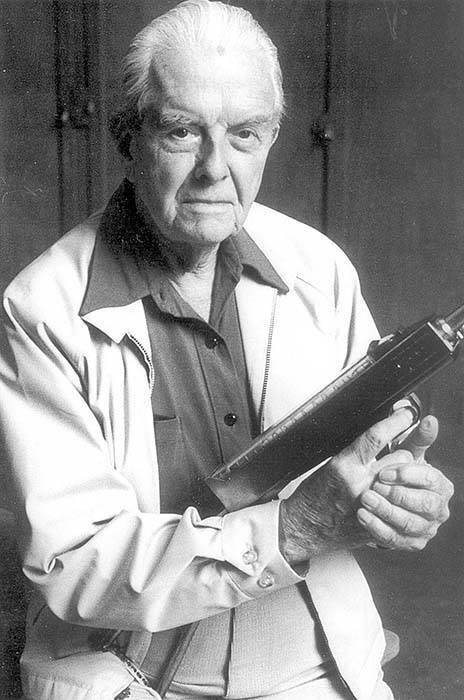 Born John Hill in the 1895 year, during the First World War, he took part in the fighting as a fighter pilot in the Royal Canadian Air Force. Despite the fact that the designer did not receive higher education, he was a well-known developer of certain technologies related to the oil refining industry and energy. So for his authorship, you can find a method of compression of natural gas, which allowed to do without the pipeline for its delivery from the well to the place of processing and storage, and this, in some cases, saved quite a lot of financial resources. The designer led many projects in Canada, Argentina, USA, but the work was not his only passion.
Born John Hill in the 1895 year, during the First World War, he took part in the fighting as a fighter pilot in the Royal Canadian Air Force. Despite the fact that the designer did not receive higher education, he was a well-known developer of certain technologies related to the oil refining industry and energy. So for his authorship, you can find a method of compression of natural gas, which allowed to do without the pipeline for its delivery from the well to the place of processing and storage, and this, in some cases, saved quite a lot of financial resources. The designer led many projects in Canada, Argentina, USA, but the work was not his only passion.Like any man, John Hill had a hobby - handguns. What was interestingly the designer was not shooting from him or collecting, he was interested in the design itself and the possibilities for its improvement.
In 1948, the designer began working on a machine gun of his own design, but in the process, the project turned from a machine gun into a submachine gun, as the main design feature, the rotary feeder, proved to be unreliable with rifle cartridges due to the bottle-shaped sleeve. In addition, the dimensions of rifle cartridges would make the weapon unnecessarily “thick”, and the automation system with such ammunition required a more detailed approach due to the complexity of the design to ensure the normal functioning of weapons with powerful ammunition. Until 5,56x45 there were still 11 years left.
In 1953, the designer presented the completed submachine gun to the military. This weapon was with a fixed wooden butt and all its appearance resembled samples of the Second World War, with the only exception that there was nowhere sticking down or sideways shop. It is noteworthy that the shop of the submachine gun was transparent, which also should be noted as a solution ahead of its time.
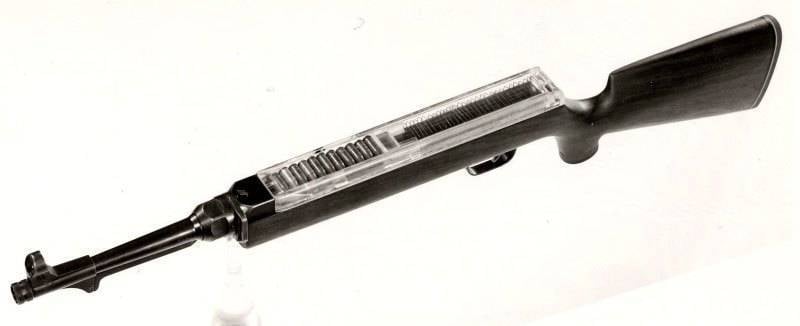
Despite the rather interesting design, the new submachine gun could not show results superior to other PPs of that time. Its main features, a reduction in the dimensions of the weapon and a roomy store, aroused interest. But since the performance characteristics of the fire were more than average, the first version of the submachine gun was rejected.
A significant role was also played by the fact that the weapon was actually turned from a piece of metal, that is, not only was it heavy, it was also expensive for both the materials expended and the work of the milling machines in the manufacturing process, which required a certain level of knowledge and skills in the production.
Despite the refusal of the military, the designer continued to work on his project, but was already guided by the needs and requirements of the police.
The first thing the designer did was to reduce the weight of his weapon as much as possible, abandoned the fixed butt, making it removable. In addition, John Hill decided to make his submachine gun convenient for firing while holding with one hand, for which he carried forward the only handle to hold the weapon.
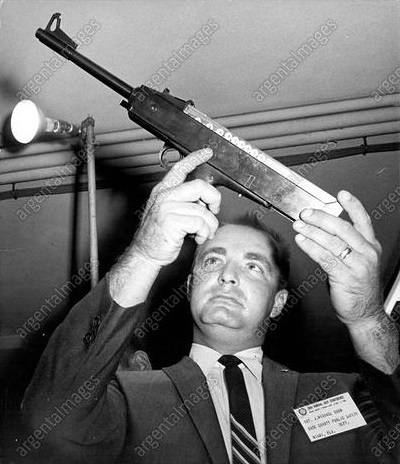 The new version of the submachine gun was shown to the police, but the weapons did not interest the police. Perhaps if this submachine gun had been developed in the 30s, it would have gained no less fame than the Thompson PP. Given its small size, this weapon with a high density of fire could be an ideal assistant to the police of that time, although with a high degree of probability it would have appeared on the other side too.
The new version of the submachine gun was shown to the police, but the weapons did not interest the police. Perhaps if this submachine gun had been developed in the 30s, it would have gained no less fame than the Thompson PP. Given its small size, this weapon with a high density of fire could be an ideal assistant to the police of that time, although with a high degree of probability it would have appeared on the other side too.In this story Hill's submachine gun is not over. In the 1963 year, with the assistance of the Browning Arms Company management team, John Heale visited the Fabrique Nationale factory with his wife, where he left one of the options for his weapon to study by local designers. Ernest Vervier highly appreciated the work of the designer, it is noteworthy that at the same time, Uziel Gal was also present at the plant, who was completely in awe of the Hill submachine gun.
Unfortunately, the serial production of these weapons was not established in Europe. One of the reasons that lie on the surface is the revision of the role of submachine guns in the army and the police. But back to being this weapon developed at least during the Second World War, it would become very popular, and since there was no demand for this PP, it would be at a loss to release it. Remained the truth is still a civilian arms market. But restrictions on the capacity of the store and the inability to conduct automatic fire completely destroyed all the advantages of the Hill submachine gun.
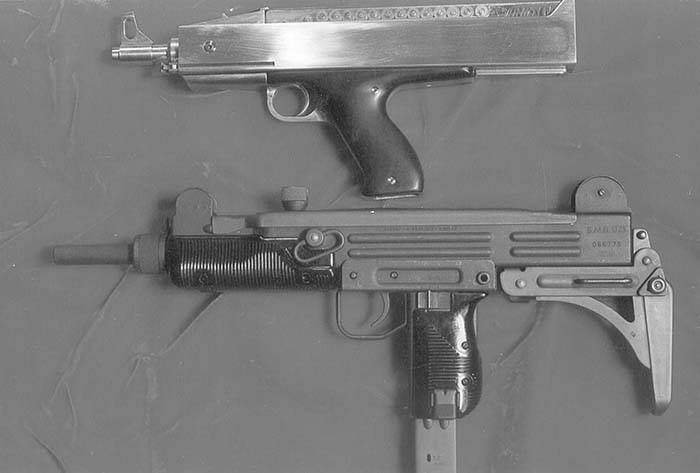
The model of the submachine gun left by John Hill, despite the high appreciation of the designers, was returned to him two years later. True, the parcel did not reach the addressee, since the US customs destroyed this sample.
Due to the absolute futility of weapons in the civilian market, the issue could not be adjusted in the United States. In addition, requirements for weapons for the civilian market were made, including the presence of a fuse, as well as firing from a closed bolt, which required processing of the design of a submachine gun and its complication.
According to some testimonies, John Hill received several proposals for the deployment of the illegal production of his PP, but he rejected them. In total, the designer produced a little less than a hundred of these submachine guns, most of which were recycled. However, in some private collections, these weapons are there and the owners are in no hurry to part with it, knowing full well the cost of these experimental samples.
The design of the machine gun John Hill
Despite the fact that several variants of submachine guns were created, they all have approximately identical design with the exception of some individual elements.
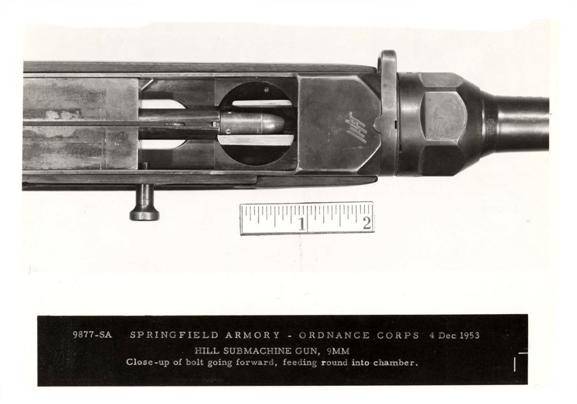 As has already become clear, the store of John Hill's pistol-machine guns is located above the receiver, that is, the cartridges are located in it perpendicular to the axis of the barrel. This solution can significantly reduce the size of the weapon, but it requires the addition of a mechanism that will feed the cartridges into the chamber, turning them 90 degrees.
As has already become clear, the store of John Hill's pistol-machine guns is located above the receiver, that is, the cartridges are located in it perpendicular to the axis of the barrel. This solution can significantly reduce the size of the weapon, but it requires the addition of a mechanism that will feed the cartridges into the chamber, turning them 90 degrees.Unlike the well-known P90, the designer decided not to place the turning mechanism in the weapon shop, since this would significantly increase the cost of the shop. The cartridge feeder was located in the weapon itself, in front of the breech breech.
Let's try to figure out how it all worked when shooting. By itself, the feed cartridge is simple to primitive. This is a cylinder that has a notch in its upper part for a cartridge, and in the lower part is a gear that interacts with a gear rack connected to the bolt of the weapon. Thus, when the bolt is in its rear position, the notch for the cartridge in the cylinder is turned perpendicular to the axis of the barrel of the submachine gun and the cartridge from the magazine enters it. When the bolt moves forward, the feed cylinder rotates and its notch together with the cartridge becomes coaxial with the barrel bore. The bolt passes through this cutout by inserting a cartridge into the chamber and a shot takes place. The recoil energy pushes the bolt back, pulls the cartridge case out of the chamber, pulls it through the cutout in the feed cylinder and throws it out. After the shutter leaves the cut-out of the cylinder, it turns but in the opposite direction and the cartridge from the magazine again gets into the cut-out, pushed by the feeder spring.
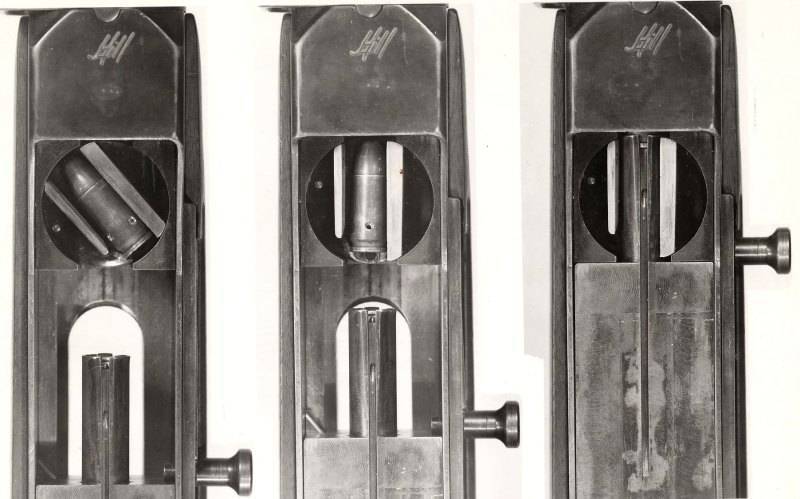
An interesting fact is that the designer worked on a slightly different cartridge supply system, when the cylinder had two notches for cartridges located perpendicular to each other. In this case, the cylinder rotated only when the shutter moved forward and remained stationary as it moved backward. Such a decision at times increased the service life, but was not implemented for several reasons.
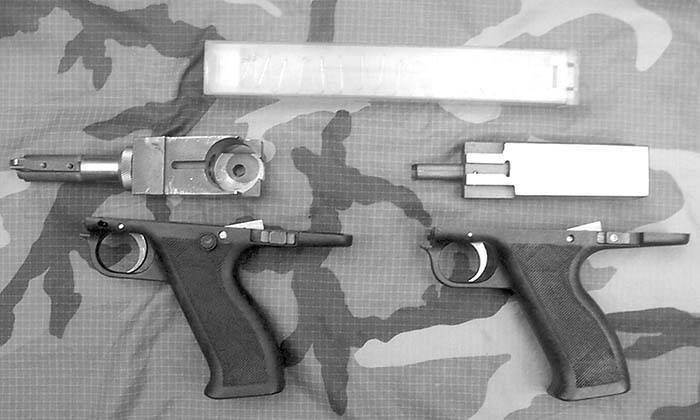
The first reason was that when the bolt moved back, it was necessary to disengage the rack and pinion. One of the most successful solutions to this problem can be considered a construction similar to a drum of a revolver, it can be seen in one of the photos. Another reason was that the new cartridge could not get into the corresponding groove only because it was hampered by the previous cartridge or bolt. As a result, the cartridge sometimes got up to a skew and did not allow the cylinder to rotate, causing a delay in firing. In the end, the designer stopped at a simpler pattern of feeding cartridges, and well, replacing worn parts was not so expensive as to make the mechanism significantly more complicated, depriving it of reliability.
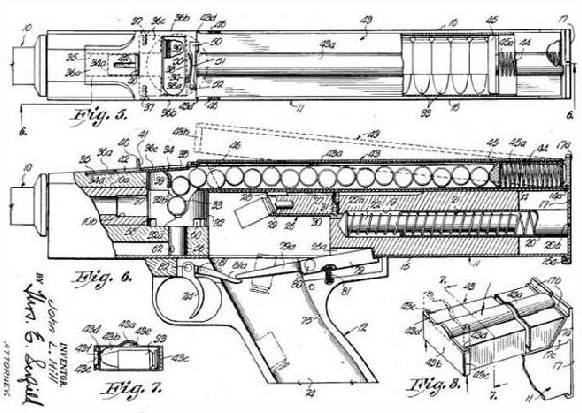 Considering Hill's submachine guns, it is impossible not to draw attention to the fact that the layout of the first model of the weapon is quite classic. If the designer had deployed the magazine to 180 degrees, then it would be possible to place a longer barrel in the same dimensions, with all the positive points that result from it. In the fixed-butt version of the weapon, it would indeed be possible to do just that, by moving the bolt group inside the butt of the submachine gun, but if you look at the weapon with the detachable butt, you will find that there is simply no free space left in it, everything takes a large bolt and a place for his movement.
Considering Hill's submachine guns, it is impossible not to draw attention to the fact that the layout of the first model of the weapon is quite classic. If the designer had deployed the magazine to 180 degrees, then it would be possible to place a longer barrel in the same dimensions, with all the positive points that result from it. In the fixed-butt version of the weapon, it would indeed be possible to do just that, by moving the bolt group inside the butt of the submachine gun, but if you look at the weapon with the detachable butt, you will find that there is simply no free space left in it, everything takes a large bolt and a place for his movement.If you started talking about the version of the John Hill submachine gun without a stock, then you should pay attention to another interesting feature of the weapon, namely, how the spent cartridges are thrown. Ejection of spent cartridges is carried out downwards, which in itself is not new, but in a weapon with a removable butt the cartridge is ejected through the cavity of the pistol grip. Such a decision is not just an interesting feature of the weapon, it also has practical value. Since the window for ejection of spent cartridges is closed, foreign objects or the shooter’s clothing cannot enter this window. In weapons with a fixed butt, especially curious could even insert a finger between the bolt and the breech.
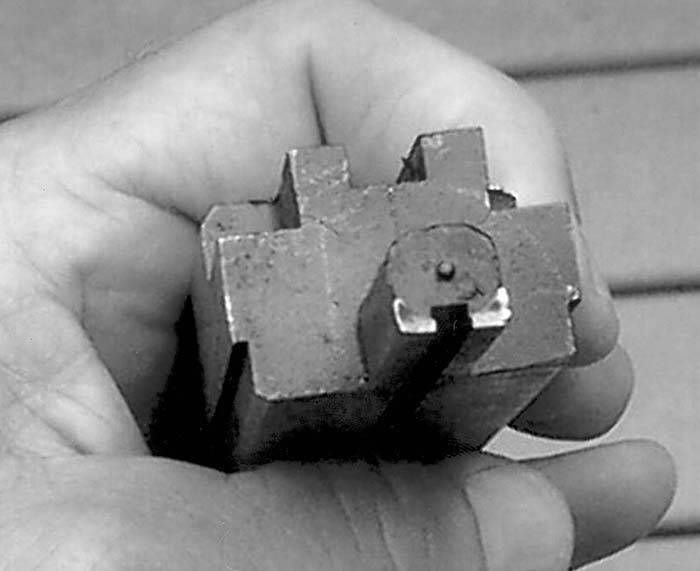
Automation of all variants of Hila submachine guns is based on a free gate with a fixed drummer. Shooting is carried out with an open shutter, which greatly affects the accuracy, but it simplifies and reduces the cost of weapon design.
Separately, you need to tell about the controls of the submachine gun. The weapon does not have a fuse switch, but there was a safety device that blocked the trigger. Unfortunately, the photographs can not be considered even where it is and what it is, especially since in some samples it is simply absent.
Interesting for its time and cocking handle. So in the version with fixed butt, the cocking handle was located on the right side of the weapon and could be embedded inside the receiver. In a submachine gun with a removable butt, the cocking handle was in front of the handle to hold the weapon under the receiver and remained stationary during firing.
A submachine gun could only fire at automatic fire with a 500-600 fire rate per minute, which, with proper skill, made it possible to shoot short bursts of cartridge 2-3.
Pros and cons of John Hill submachine guns
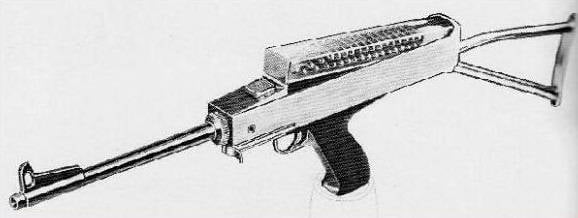 The main positive features of this weapon are certainly its dimensions and roomy store. However, along with this, it is impossible not to note the simplicity of the design of the weapon and the absence of any small details. Of course, a kind of primitive execution of the trigger mechanism and the bolt group left its mark on the characteristics of the weapon, making them far from the most outstanding, but any weapon is a balance between reliability, low cost, weight and size characteristics, usability and combat characteristics. When this balance is maintained, then the output is quite unremarkable weapon, but when the designer puts something one above the other, you can often see the result of his work a unique sample, unlike others, and in certain situations more acceptable than the weapon of common designs.
The main positive features of this weapon are certainly its dimensions and roomy store. However, along with this, it is impossible not to note the simplicity of the design of the weapon and the absence of any small details. Of course, a kind of primitive execution of the trigger mechanism and the bolt group left its mark on the characteristics of the weapon, making them far from the most outstanding, but any weapon is a balance between reliability, low cost, weight and size characteristics, usability and combat characteristics. When this balance is maintained, then the output is quite unremarkable weapon, but when the designer puts something one above the other, you can often see the result of his work a unique sample, unlike others, and in certain situations more acceptable than the weapon of common designs. If we talk about the shortcomings of the Hill submachine guns, then here first of all it is necessary to note its mass and the amount of metal necessary for its production. In principle, the design could be easily cheapened, but it is advisable with a serial release. If you touch the reliability of the weapon, the submachine gun can experience certain problems when firing in an upside down position. In particular, the option with a removable butt may fail due to the fact that the spent cartridges will begin to accumulate in the hollow handle of the weapon. But on the other hand, how often do you have to shoot upside down?
If we talk about the shortcomings of the Hill submachine guns, then here first of all it is necessary to note its mass and the amount of metal necessary for its production. In principle, the design could be easily cheapened, but it is advisable with a serial release. If you touch the reliability of the weapon, the submachine gun can experience certain problems when firing in an upside down position. In particular, the option with a removable butt may fail due to the fact that the spent cartridges will begin to accumulate in the hollow handle of the weapon. But on the other hand, how often do you have to shoot upside down?Conclusion
For some reason, self-taught gunsmiths are very sympathetic, as well as what they develop. Perhaps the reason is that without special education, people do not think out of patterns, sometimes doing something that the other would not even undertake in view of the complexity of implementation.
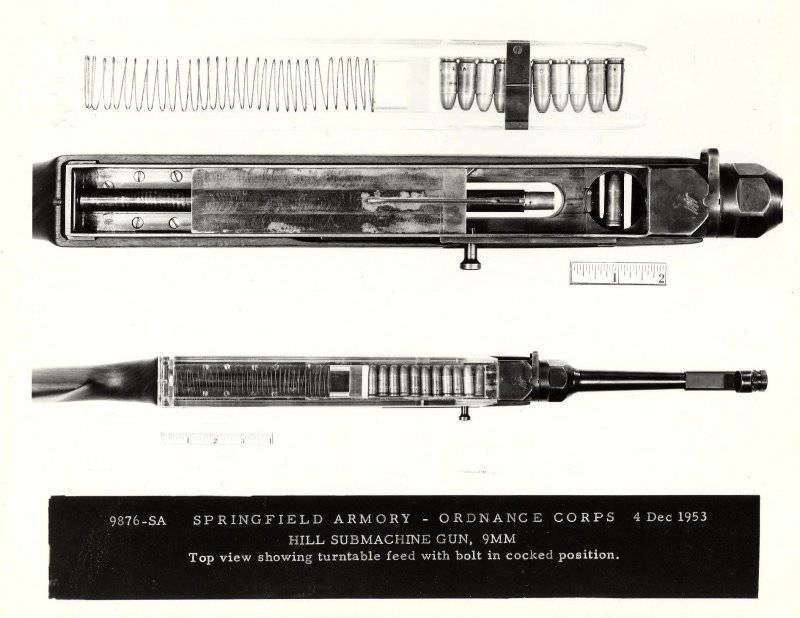
Usually about designs with custom design say that they are ahead of their time. In the case of John Hill's submachine guns, this phrase can be somewhat expanded - the weapon did not appear in its time.
If the designer had created his submachine gun at least twenty years earlier, it would not just become popular, perhaps it would become one of the best for that time, since the role of the submachine gun was then quite significant. The return of the P90 submachine gun says that the design has the right to life and could find its niche if it were developed later.
- Mark Poddubny
- raigap.livejournal.com, soldierweapons.ru, smallarmsreview.com
Information